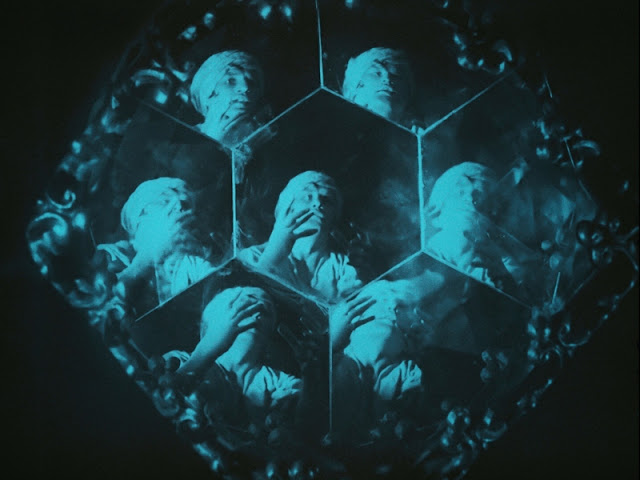(1924) Directed by Paul Leni; Written by Henrik Galeen; Starring: Emil Jannings, Conrad Veidt, Werner Krauss, William Dieterle and Olga Belajoff; Available on Blu-ray and DVD
Rating: ***½
Horror anthologies (and omnibus movies in general) are a special breed of film, providing several complete segments, linked by a branching story. As a result of their episodic nature, they’re often a mixed bag to watch, frequently varying in tone and quality. The beauty of the format, however, is that if you don’t like one story, you usually don’t have to wait too long for the next. Amicus productions arguably perfected the horror portmanteau in the ‘60s and ‘70s, with a string of macabre offerings, starting with Dr. Terror’s House of Horrors (1965), which was directly influenced by Dead of Night (1945). If Dead of Night was the father of the format, then the grandad was 1924’s Waxworks (aka: Das Wachsfigurenkabinett)* from director Paul Leni (The Man Who Laughs, The Cat and the Canary) and writer Henrik Galeen (Nosferatu: A Symphony of Horror). Leni, who worked in many aspects of filmmaking, brought his signature visual flair to the film, before moving to Hollywood for the remainder of his all-too-brief career.*/**
* Not-So-Fun-Fact #1: The original negative burned in 1925. The reconstructed 82-minute version that exists today is derived mainly from a British print, and is 25 minutes shorter than the version that premiered in Germany.
** Not-So-Fun-Fact #2: Leni’s career was tragically cut
short when he died of blood poisoning in 1929, only a couple of years after
moving to Hollywood.
In the framing story, a young writer (William Dieterle) visits a carnival sideshow featuring wax figures of some of history’s most notorious individuals: Harun Al-Rashid, Ivan the Terrible, Jack the Ripper and Rinaldo Rinaldini. After catching the eye of the proprietor’s daughter (Olga Belajoff), he’s hired to write their checkered backstories, which follow in a trio of segments. */**
* Fun Fact #1: Why only three segments? Plans for a fourth story, concerning the Italian gentleman thief Rinaldo Rinaldini, were scuttled when the filmmakers ran out of funds.
** Fun Fact #2: when the film premiered in its native
Germany the order of the stories was completely different, starting with Ivan
the Terrible, followed by Jack the Ripper, and concluding with Harun Al-Rashid.
Compared to the lighter tone of the first segment, the second,
with Ivan the Terrible (Conrad Veidt), is noticeably darker. The focal point of
the story is Ivan’s hourglass, which marks the time a poisoned victim has to
live – it’s fittingly ironic that the device becomes the instrument of his
eventual comeuppance. Veidt shines as the Russian despot, who keeps the
population ensnared in a web of fear. Despite Veidt’s imposing performance and
unique set design, the pacing is inconsistent in the second story, making it
seem subjectively longer than the preceding (and objectively longer) segment.
The third segment, by far the shortest,* focuses on Jack the Ripper (or “Spring-Heeled Jack” in the English-language version). It’s not big on story or plot, but a nightmare come to life. The writer falls asleep, dreaming he’s relentlessly pursued through the back streets and alleys by the ignominious killer (played by Werner Krauss, who also appeared as the titular Dr. Caligari).
* Fun Fact #3: According to Julia Walmüller, who was
involved with the film’s restoration, the Jack the Ripper story was always the
shortest segment.
Waxworks isn’t easily classified into one genre – not exactly horror, but horror-adjacent. While largely an exercise in style over substance (the superior Harun Al-Rashid segment notwithstanding), it’s undeniably gorgeous to look at. Although the sum is less than it could have been, Waxworks deserves its place as a revered classic that belongs on anyone’s list of must-see silent films.
Sources for this article: Flicker Alley Blu-ray commentary
by Adrian Martin; “In Search of the Original Version of Paul Leni’s Das
Wachsfigurenkabinett: Interview with Julia Walmüller (Deutsche Kinomathek)”
(2020)








It's visually stunning, and yes it's style over substance, but such style! At the time they were making these films, they didn't really have genres so modern viewers have to adapt a little.
ReplyDeleteArguably, the style is the substance. :) ... And it's comforting to know some films don't fit into neat little boxes, regarding genre.
DeleteIntriguing review, Barry! I have never heard of waxworks but it sounds interesting and a bit different for silent films. I was hoping to hear that the Jack the ripper story was the most interesting since the killings had been recent history at the time. Overall though, it sounds totally worth experiencing!
ReplyDeleteThanks, John! The visuals are the thing with this movie. The "Jack the Ripper" sequence was far too short, in my opinion, but it works well enough as a mood piece.
DeleteGreat choice for Silent September Barry! I've only seen this once, quite some time ago, but your review reminded me of that wonderfully wild Caliph segment. The silent format encouraged filmmakers to invest so much in visual details -- sets, costumes, backgrounds. The best of these films are the equivalent of live-action masterwork paintings.
ReplyDeleteThank you! It's such a visual feast. Virtually any still from this film is a piece of art.
Delete